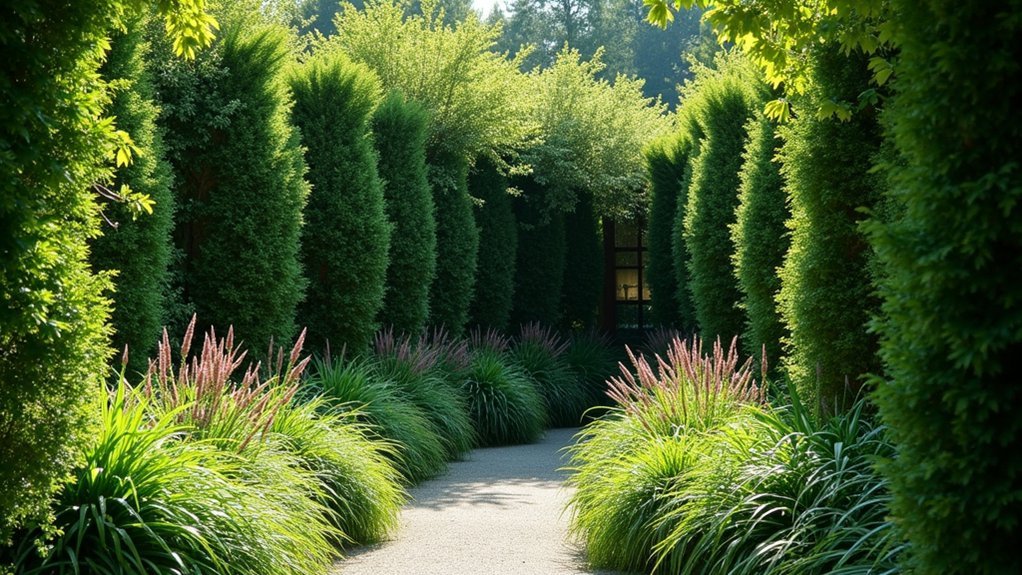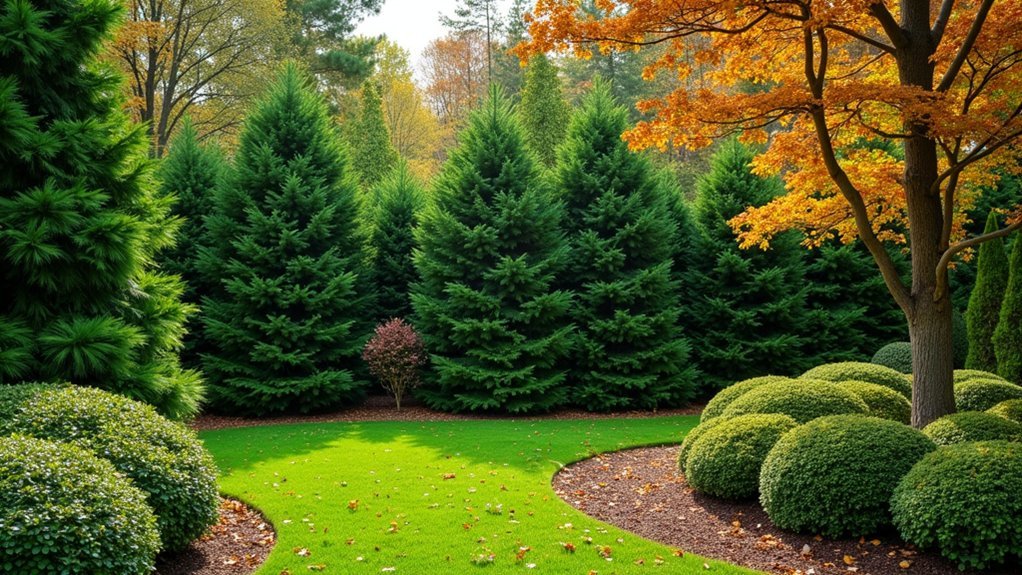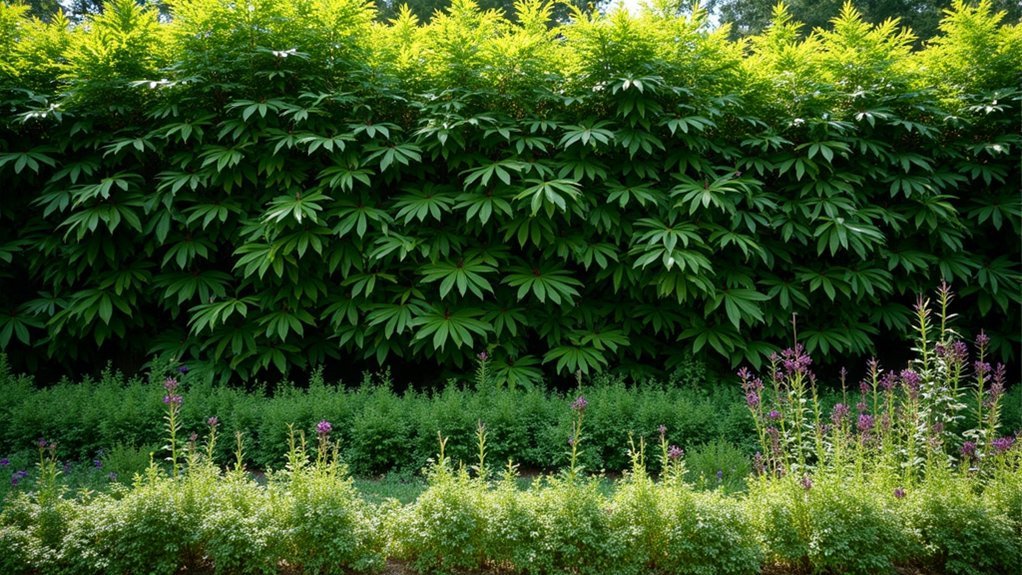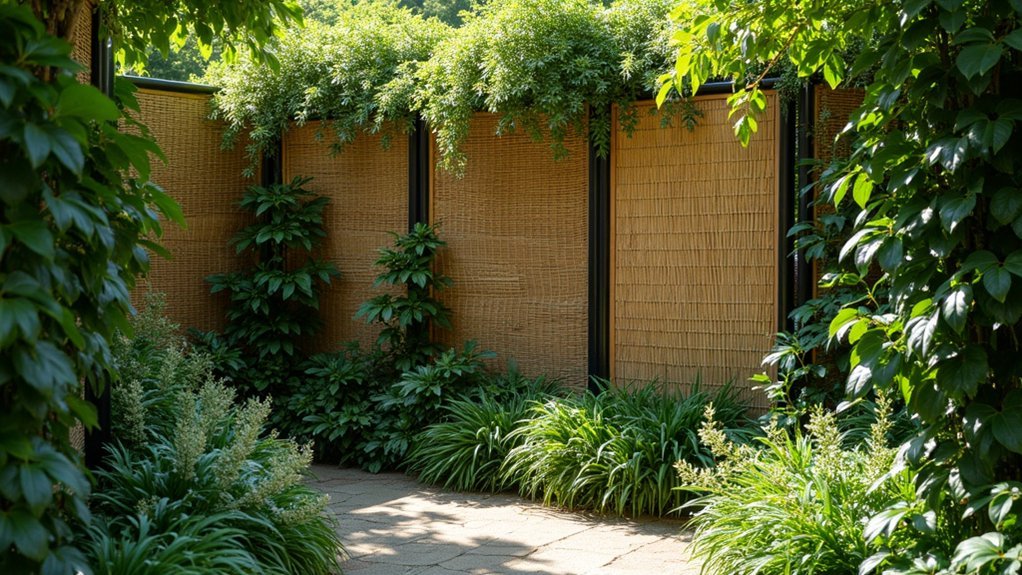Layered privacy screens create depth by staggering plants of varying heights, textures, and seasons. Start with tall evergreens as your backdrop, add mid-height deciduous shrubs, then finish with shorter flowering plants in front. You’ll get year-round coverage plus seasonal interest when you mix fast-growers like arborvitae with colorful options like dogwood or ninebark. This natural approach not only shields your space but also supports local wildlife and reduces maintenance costs over time.
The Art of Layered Planting for Natural Privacy

While traditional privacy solutions often look rigid and artificial, layered planting offers a more organic approach to creating seclusion in your outdoor space. This design strategy involves staggering plants in a thoughtful arrangement—typically with tall evergreens as the backdrop, deciduous trees or shrubs in the middle, and shorter plants in front.
You don’t need to follow strict height progression; creative designs can incorporate varied heights throughout your garden. By combining evergreens for year-round screening with deciduous varieties that change seasonally, you’ll create both privacy and visual interest.
The key is ensuring each plant has adequate space to grow without overcrowding. This approach not only creates an effective privacy screen but also delivers a landscape that evolves with the seasons, offering ongoing beauty and protection. Creating effective privacy screens requires focusing on depth and flow to connect different areas of your landscape while maintaining visual interest through staggered arrangements.
Selecting Fast-Growing Plants for Immediate Screening
When privacy can’t wait, fast-growing plants become your garden’s best allies. Arborvitae leads the pack, growing up to three feet annually while providing dense evergreen coverage year-round.
Choose plants that match your hardiness zone and consider their mature size to guarantee they’ll fit your space long-term. For tropical areas in zones 10-11, Burgundy Queen Bougainvillea creates stunning living walls with its vibrant flowering vines.
Selecting zone-appropriate plants with mature dimensions in mind ensures privacy solutions that truly last.
- Arborvitae – Excellent evergreen option with rapid growth and drought tolerance
- Red Twig Dogwood – Adds winter interest with vibrant stems when privacy needs persist
- Ninebark – Offers colorful foliage options while establishing quickly
- Yew – Versatile and durable across various conditions
- Forsythia – Provides early spring blooms with moderate growth rate
Remember to assess your light conditions before selecting plants—most fast-growing privacy options prefer full sun to part shade for peak development.
Combining Evergreens and Deciduous Plants for Year-Round Coverage

Creating the perfect privacy screen requires strategic thinking beyond mere growth rates. Mixing evergreens with deciduous plants offers superior coverage and resilience compared to single-species approaches.
Pair columnar Emerald Green Arborvitae with vibrant red-twig dogwood for year-round interest. The arborvitae provides constant screening while dogwood’s winter stems create visual appeal when deciduous plants shed leaves. This combination also hedges against disease risks inherent in monocultures.
For a naturalized look, stagger Canadian Hemlock behind flowering Viburnum or Hydrangea paniculata. Bright N Tight™ Carolina Laurel creates an excellent foundation with its shiny, deep-green foliage that maintains a tidy appearance year-round. Position plants in alternating rows to avoid a formal grid appearance. Apply mulch between layers to minimize root competition.
Remember to synchronize maintenance: prune evergreen leaders in early spring and trim deciduous plants after flowering to preserve their natural form and blooming potential.
Design Principles for Multi-Dimensional Garden Barriers
To create effective multi-dimensional garden barriers, you’ll need to vary heights strategically among your plantings and structural elements.
This height variation adds visual interest while maintaining the functional aspects of your privacy screen. When you establish a visual rhythm through alternating tall, medium, and short elements, you create a more natural-looking barrier that draws the eye across your landscape rather than highlighting its boundary nature. Incorporating trees with different forms such as columnar or weeping will enhance the vertical dimension of your privacy screen while creating distinctive silhouettes against the sky.
Height Variations Matter
Effective privacy screens rely on strategic height variations that work in harmony with your garden’s design.
When planning your natural barrier, you’ll want to combine plants of different heights to create depth while maintaining the privacy you need.
- Mix tall ornamental grasses (like Panicum or Miscanthus) with smaller trees for both screening and visual interest.
- Layer taller plants at the back with progressively shorter varieties toward the front for a natural, unconfined feel.
- Consider seasonal changes—deciduous plants offer privacy in summer while allowing winter light.
- Stagger your plantings rather than creating straight lines to achieve a more relaxed, natural barrier.
- Combine living elements with structures like pergolas or trellises for enhanced screening where needed.
This multi-dimensional approach allows privacy to become a byproduct of aesthetics rather than creating an obvious barrier that might make your space feel smaller.
Creating Visual Rhythm
Visual rhythm brings life to privacy screens, transforming them from mere barriers into enchanting landscape features. By repeating similar plants, shapes, and colors throughout your design, you’ll create a cohesive flow that guides the eye through your garden space.
Incorporate alternating elements—mix tall grasses with flowering shrubs or combine varied textures to establish dynamic patterns. Consider gradation by gradually changing plant sizes from one end to another, creating a sense of movement and energy.
You can also utilize radiation by designing elements that spread outward from a central focal point. Strategic placement of hardscape features like stepping stones or decorative walls can reinforce the rhythm established by your plants.
Don’t forget how seasonal changes affect your rhythm. Select plants that provide year-round interest through changing foliage colors, blooming cycles, or distinctive winter silhouettes.
This thoughtful approach guarantees your privacy screen maintains visual harmony while engaging viewers throughout the seasons.
Maintenance Strategies for Thriving Privacy Hedges

The long-term success of your privacy hedge depends on five essential maintenance practices that work together as an integrated system.
Implement these techniques consistently to transform a basic planting into a lush, enduring privacy screen.
Consistent application transforms ordinary hedges into magnificent living walls that stand the test of time.
- Prune strategically during late winter dormancy, removing no more than two-thirds of foliage and using the three-year rejuvenation method for mature hedges.
- Water deeply but infrequently in the morning using drip irrigation to develop strong root systems while preventing fungal issues. Applying water at the base of plants helps avoid wetting the foliage and encourages deep root growth.
- Apply balanced, slow-release fertilizers after soil testing, supplementing with organic mulch to regulate soil conditions.
- Prevent pest infestations through neem oil applications and sanitation pruning before problems spread.
- Install appropriate supports including temporary fencing or trellises during the establishment phase to maintain structural integrity.
Enhancing Your Screen With Flowering and Fragrant Varieties
A well-designed privacy screen can delight more than just your sense of sight when you incorporate strategically placed flowering and fragrant varieties throughout your landscape.
You’ll create a more immersive outdoor experience by mapping fragrance zones that offer seasonal scent changes, from Winter Daphne’s early spring perfume to Summersweet’s summer blooms that attract pollinators.
Layering different sensory elements—visual blooms like Sensation Lilac’s purple-white flowers, aromatic plants like Natchez Mock Orange, and year-round screening from evergreens like Fragrant Olive—transforms a simple barrier into a multi-sensory living boundary that enhances your privacy and garden enjoyment. Consider including deer-resistant options like Mexican Orange Blossom for areas where wildlife pressure is a concern.
Seasonal Bloom Planning
Creating a privacy screen that delights throughout the year requires thoughtful selection of flowering and fragrant varieties with staggered bloom times.
By combining early bloomers like lilacs with mid-season hydrangeas and fall-flowering viburnums, you’ll enjoy continuous color and fragrance across seasons.
- Position fragrant plants near walkways and seating areas for maximum enjoyment
- Combine evergreen flowering species like camellias with deciduous bloomers for year-round interest
- Mix plants with contrasting foliage colors and textures to create visual depth
- Include climbing varieties such as clematis and honeysuckle for vertical floral interest
- Prune after peak bloom periods to encourage reblooming and maintain your screen’s shape
When planning your planting schedule, consider mature sizes to prevent overcrowding, and maintain proper watering to support vigorous flowering throughout each plant’s bloom cycle.
Consider incorporating Clematis species for their climbing habit and vibrant blooms that complement other privacy screen plantings.
Fragrance Zone Mapping
Mapping your garden’s fragrance zones transforms ordinary privacy screens into sensory experiences that delight throughout the day.
Consider incorporating both morning and evening fragrant varieties to guarantee continuous aromatic presence.
Create depth by layering plants of various heights—tall magnolias and crape myrtles as backdrops, viburnums and lilacs in the middle, and low-growing flowers in front.
Plant in small groups using a staggered pattern to maximize fragrance dispersion while maintaining a natural appearance.
You’ll benefit beyond just scent—these fragrant barriers reduce noise, block wind, improve air quality, and attract beneficial wildlife.
Choose diverse species to prevent disease spread and guarantee year-round interest with evergreen varieties.
For optimal fragrance performance, consider the USDA Growing Zones of your selected plants to ensure they thrive in your climate conditions.
As your plants mature, you can adjust their arrangement to maintain ideal density and fragrance distribution.
Multi-Sensory Privacy Borders
Beyond simple visual shields, multi-sensory privacy borders transform outdoor spaces into immersive retreats that engage all five senses.
By thoughtfully integrating plants that offer colorful blooms, pleasant fragrances, varied textures, and elements that create gentle sounds, you’ll create a living barrier that’s both functional and experiential.
- Visual impact: Choose plants with vibrant flowers and interesting growth patterns for year-round appeal
- Aromatic elements: Incorporate fragrant varieties like lavender or roses to enhance mood and reduce stress
- Sound design: Select bird-attracting plants and add wind chimes or rustling grasses
- Tactile dimensions: Mix textures from soft lamb’s ear to rough bark for tactile exploration. These varied textural elements support sensory exploration and can be particularly beneficial for individuals seeking sensory stimulation.
- Accessibility features: Include smooth pathways and sensory elements at various heights for all users
Ecological Benefits of Living Privacy Barriers
When you install living privacy barriers instead of traditional fencing, you’re not just creating a boundary—you’re establishing a miniature ecosystem that delivers significant environmental benefits. Your living fence actively sequesters carbon, with mature hedgerows capturing up to 800 pounds of CO2 annually while filtering harmful pollutants from the air. These living barriers prevent soil erosion through extensive root systems while creating essential habitats for wildlife and beneficial insects, supporting your local ecosystem’s health and resilience. The strategic placement of living fences along waterways and hillsides further stabilizes banks and improves water absorption into the soil.
| Benefit | Impact | Best Plants |
|---|---|---|
| Carbon Sequestration | 600-800 lbs CO2 annually | Arborvitae, Holly |
| Erosion Control | 50% less topsoil loss | Juniper, Bayberry |
| Biodiversity | Habitat for birds & pollinators | Berry-producing shrubs |
| Maintenance | 60-80% cost reduction | Local species |
| Economic Value | $15-25 harvest per linear foot | Edible varieties |
Frequently Asked Questions
How Do Privacy Screens Affect Property Values?
Privacy screens boost your property’s value by enhancing curb appeal, adding natural aesthetics, improving security, reducing noise, and creating desirable outdoor living spaces. They’re an eco-friendly, cost-effective investment with long-term benefits.
Can Plant Screens Create Legal Issues With Neighbors?
Yes, your plant screens can create legal issues if they violate height restrictions, block protected views, encroach on property lines, or appear deliberately malicious. Always check local ordinances and communicate with neighbors beforehand.
How Do Privacy Plants Interact With Existing Irrigation Systems?
You’ll need to modify existing irrigation systems with drip emitters near root zones. Check flow rates, adjust pressure for different plant needs, and create separate zones for species requiring varied watering schedules.
What Alternatives Exist for Renters or Temporary Living Situations?
You’ll find several renter-friendly options including portable dividers, fabric screens, removable trellises, and foldable outdoor screens. Mobile plant boxes, temporary window decals, and hanging vines also create privacy without permanent installations.
How Do Plant Barriers Perform in Extreme Weather Conditions?
Plant barriers can withstand extreme weather when properly designed. You’ll find deep-rooted species resist flooding, flexible trees endure high winds, and layered plantings buffer temperature extremes better than single-row arrangements.
In Summary
By creating layered privacy screens with diverse plants, you’ve not only shielded your space from unwanted views but also cultivated a living sanctuary. Your thoughtful combination of evergreens, fast-growing varieties, and flowering plants offers year-round protection while supporting local wildlife. With proper maintenance, your natural barrier will continue to evolve, providing both privacy and pleasure for years to come. It’s truly the perfect blend of function and beauty.





Leave a Reply